Dell Precision M6700 Notebook Review: The Enterprise Split
by Dustin Sklavos on December 12, 2012 7:43 PM ESTDisplay Quality
For whatever reason, ColorEyes Display Pro just refuses to cooperate with the LG Philips IPS panel Dell uses in their Precision M6700 unless you calibrate at a Gamma of 1.8 instead of 2.2. This produces a fine image, but it visibly loses a lot of the pop, saturation, and gamut of the display's default calibrations. Note that Dell includes PremierColor software that actually allows you to switch between different color gamuts, and it's a welcome feature.
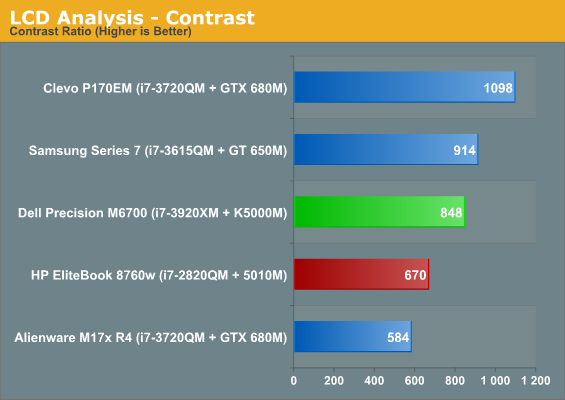
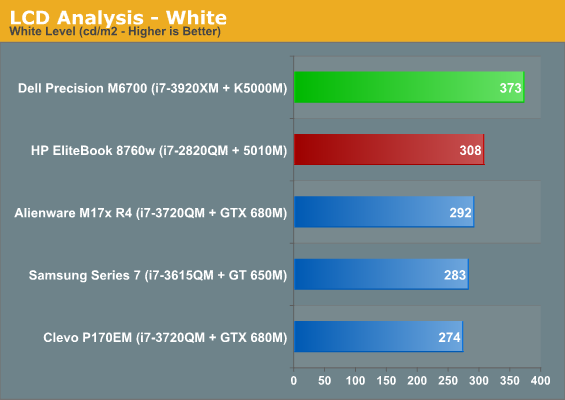

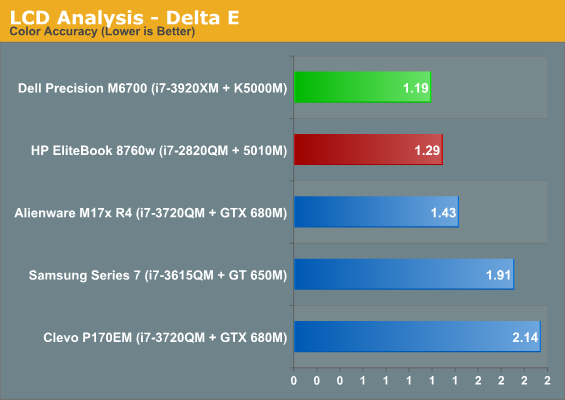

The measurements are generally solid, with the PremierColor display at least offering a solid sRGB color gamut. Unfortunately due to issues with ColorEyes Display Pro I'm unable to confirm whether or not it can truly produce the entire AdobeRGB1998 color gamut like Dell claims it can, but honestly I believe it can.
Frankly it's a beautiful display and anecdotally it's on par with the DreamColor display-equipped EliteBook I currently have in house for testing, maybe even a step up due to Dell's PremierColor software which allows you to not only choose the color gamut you want to work with, but will even detect applications and adjust accordingly.
Battery Life
Where these workstations are still lagging substantially behind their consumer counterparts is in their power management technology. NVIDIA's Optimus has been thriving for years now on consumer GPUs, but Quadro chips still don't benefit from it. AMD just got Enduro working well on their mobile GPUs, but it's not functioning on FirePro chips either. As a result, the Dell Precision M6700 is forced to employ an oversized battery to compensate.
Update: Mea culpa. While Optimus is functional on NVIDIA's mobile Quadro GPUs, the use of a 10-bit IPS panel (along with either a 120Hz panel or touchscreen) precludes it due to bandwidth limitations. As a result, the M6700's battery life is going to be substantially lower with the PremierColor display, but I would actually expect M6700s with a standard TN panel to produce running time closer to the Alienware M17x R4, which has a smaller battery but similar silicon.

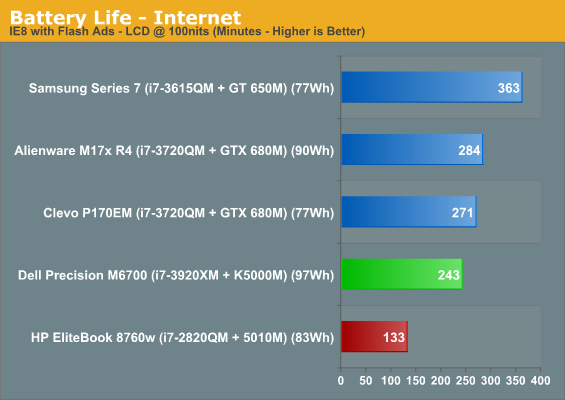
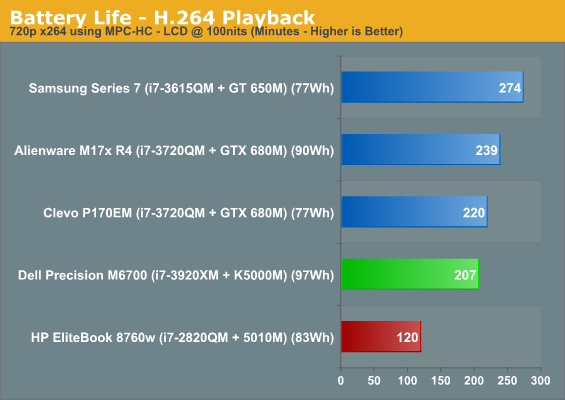
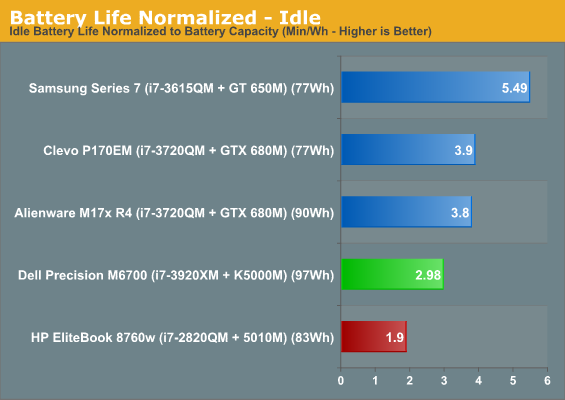
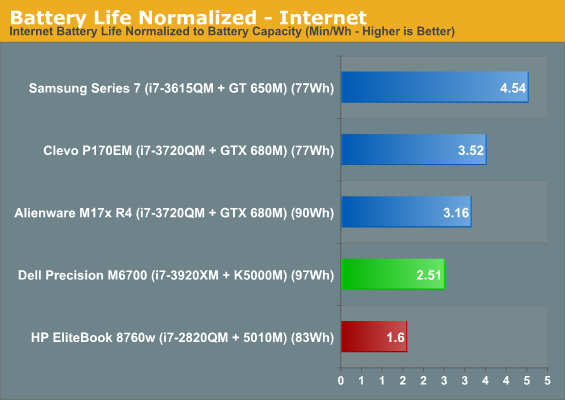
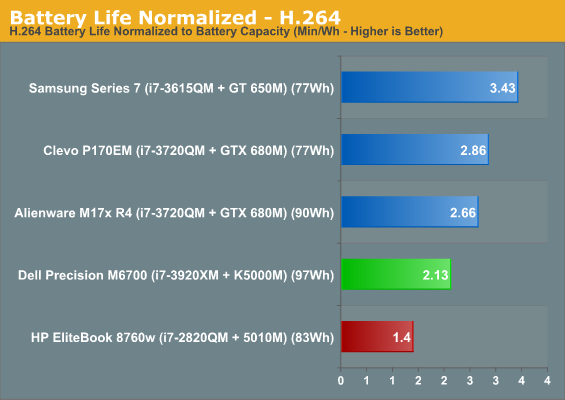
Optimus-enabled notebooks are able to get at least a little more mileage. The M6700's battery life actually isn't that bad given that it's a workstation notebook, owing at least somewhat to both Ivy Bridge's frugal power consumption and Kepler's superior idle power compared to Fermi.
Heat and Noise
Thankfully, the Dell Precision M6700's beefy cooling system keeps the notebook running both reasonably cool and quiet. Keep in mind that we're working with a combined TDP of roughly 155W on the CPU and GPU in this system when you take a look at the thermals below.

The CPU runs nice and toasty, but the M6700 is actually very effective at keeping the K5000M cool. Noise levels are very good, with the notebook basically inaudible at idle and fan noise being a low, quiet whoosh under load.


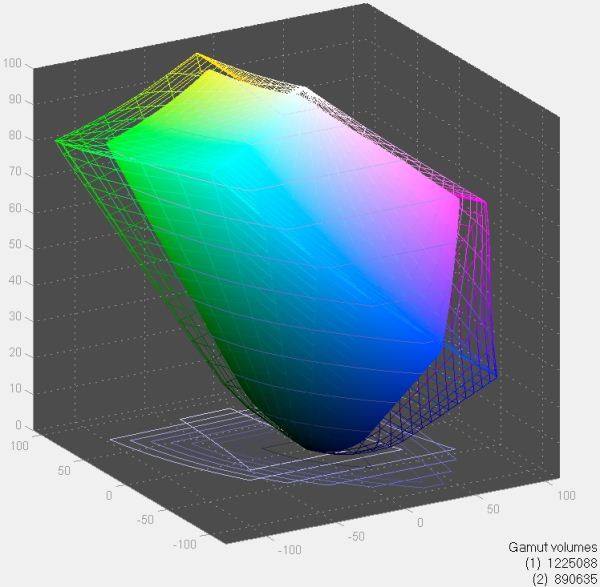








125 Comments
View All Comments
bramv101 - Thursday, December 13, 2012 - link
I agree with most comment above. I use this workstation for small FEA and CFD runs.This is not to be compared to a Macbook pro, which is a machine for graphic design.
I dont think any serious engineer would consider a macbook pro for these type of tasks
j_newbie - Thursday, December 13, 2012 - link
@Dustin Sklavos,Looks like Anandtech readership has a high percentage of mechanical engineers using fea and cfd programs. The benchmarks provided focus mainly on 3d modelling performance.
One benchmark you could consider adding is specfp 2006.
Since I am the IT dept in a small (15 engineers) services firm in Bangalore, I find it to be one of the most usable benchmarks for FEA and CFD.
These programs rely on four things:
FLOPS, memory bandwidth, memory size, disk speed.
An alternative would be to ask ansys for a 64 bit copy to run benchmarks on
something like these http://www.padtinc.com/support/ansys-benchmarks.ht...
Hope these will help,
cheers,
borceg - Thursday, December 13, 2012 - link
Could you make a review for Lenovo ThinkPad W530 ?critical_ - Thursday, December 13, 2012 - link
I've owned a W520, W530 and own a M6700 right now. It is a smaller machine with a slower graphics card. The only thing that bothers me on the W530 is the cooling system isn't great.borceg - Friday, December 14, 2012 - link
I'm looking for 15-inch machine, GPU either k1000m or k2000m should be fine. I'm not working with some ultra heavy CAD.How is build quality, screen, keyboard and touch-pad ?
borceg - Friday, December 14, 2012 - link
And according to this review, http://www.notebookcheck.net/Review-Lenovo-ThinkPa... temp seems fine to me (maybe I'm wrong)bernstein - Thursday, December 13, 2012 - link
with these machines the choice chart it is really really simple.as long as you satisfy one of these your set. otherwise buy a macbookpro or similar.
1) you must have a quadro/firepro gpu
2) you must have > 16GB RAM
3) you can't live with 6% less cpu ghz
4) you must have a 10bit panel
and seriously hope you don't care about weight, build quality & usability...
Jaguar36 - Thursday, December 13, 2012 - link
A bunch of folks I work with have these, and I'm shocked at the size of the power brick. Its about the same size as a regular desktop powersupply, and weighs more than some smaller laptops. That's completely unacceptable. Most people I know had to get two power supplies so they could leave one at the office.Also no-one should be comparing this to an Apple anything, nobody is going to cross shop the two.
DanNeely - Thursday, December 13, 2012 - link
It's a 240W power supply; so of course it's going to be bigger than the normal 50/100W units that come with IGP/low end discrete GPU laptops. That said, unless Dell's serving up the wrong picture it looks like it's roughly 3x5x1" in size; and while the former two numbers roughly match up with an ATX supply; the latter is typically at least 5" (for the 120mm fan) in the third.Jaguar36 - Thursday, December 13, 2012 - link
Just measured one, its 4"x7.5"x1.75" or so. It's completely ridiculous.